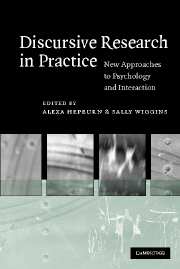Book contents
- Frontmatter
- Contents
- List of figures
- List of contributors
- Acknowledgements
- 1 Discursive research: themes and debates
- Part I Psychology in action
- Part II Professionals and clients
- 7 When patients present serious health conditions as unlikely: managing potentially conflicting issues and constraints
- 8 Arguing and thinking errors: cognitive distortion as a members' category in sex offender group therapy talk
- 9 Members' and analysts' interests: ‘formulations’ in psychotherapy
- 10 ‘Suppose it wasn't possible for you to go any further with treatment, what would you do?’ Hypothetical questions in interactions between psychiatrists and transsexual patients
- Part III Youth and institutions
- Appendix: transcription notation
- References
- Index
10 - ‘Suppose it wasn't possible for you to go any further with treatment, what would you do?’ Hypothetical questions in interactions between psychiatrists and transsexual patients
Published online by Cambridge University Press: 04 November 2009
- Frontmatter
- Contents
- List of figures
- List of contributors
- Acknowledgements
- 1 Discursive research: themes and debates
- Part I Psychology in action
- Part II Professionals and clients
- 7 When patients present serious health conditions as unlikely: managing potentially conflicting issues and constraints
- 8 Arguing and thinking errors: cognitive distortion as a members' category in sex offender group therapy talk
- 9 Members' and analysts' interests: ‘formulations’ in psychotherapy
- 10 ‘Suppose it wasn't possible for you to go any further with treatment, what would you do?’ Hypothetical questions in interactions between psychiatrists and transsexual patients
- Part III Youth and institutions
- Appendix: transcription notation
- References
- Index
Summary
Introduction
Psychiatrists, like other medical professionals with a diagnosing or prescribing role, control access to a range of forms of treatment, medication and service that their patient, or their patient's carer, may want access to. This ‘gatekeeping’ role is particularly acute in settings where a patient's desire for a certain medicine or treatment (e.g., for the drug methadone, or for ‘cross-sex’ hormones and sex reassignment surgery) may also be interpreted as a symptom of their ‘condition’ (e.g., heroin addiction, or transsexualism). The UK National Health Service (NHS) Gender Identity Clinic (GIC), is one setting where the psychiatrist's gatekeeping role is renowned.
Practitioners in a GIC deal primarily with patients who self-identify as ‘transsexual’. Transsexualism is formally designated in the Diagnostic and Statistical Manual of Mental Disorders (DSM-IV, 1994) as a ‘Gender Identity Disorder’ (GID). Persons diagnosed with GID are said to exhibit ‘a strong and persistent cross-gender identification and a persistent discomfort with their sex or a sense of inappropriateness in the gender role of that sex’ (The Harry Benjamin International Gender Dysphoria Association, 2001: 4). Statistically, transsexualism is thought to affect 1 in 11,900 males and 1 in 30,400 females (ibid., 2001: 2). The treatment for the majority of transsexuals consists of taking high doses of cross-sex hormones (Hormone Replacement Therapy), and undergoing Gender/Sex Reassignment Surgery (GRS/SRS) (Green, 2000).
In order to obtain hormones and be referred for surgery, pre-operative transsexuals must be assessed by two psychiatrists at a Gender Identity Clinic.
Information
- Type
- Chapter
- Information
- Discursive Research in PracticeNew Approaches to Psychology and Interaction, pp. 182 - 200Publisher: Cambridge University PressPrint publication year: 2007
Accessibility standard: Unknown
Why this information is here
This section outlines the accessibility features of this content - including support for screen readers, full keyboard navigation and high-contrast display options. This may not be relevant for you.Accessibility Information
- 4
- Cited by
